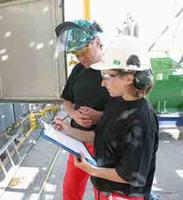LCA (Life Cycle Assessment) is a quantitative and objective method to evaluate environmental loads (consumption of material and energy resources, emission of environmental load substances and wastes), through all phases of a product including resource extraction, production, use and waste disposal.
By using LCAs correctly it can be ensured that:
- Product systems are not erroneously favoured or condemned on the basis of individual results.
- Developments do not inadvertently shift or even increase environmental impact but in fact reduce it.
- The resources available are directed in such as way that they achieve the greatest environment benefit for the entire system.
PVC product systems have been investigated using LCA methodology in almost all significant application areas in terms of production quantity.
Overview on PVC and LCAs: the PE/Stuttgart Report
As part of a full review of PVC, the independent and reputed PE Europe Consulting Group together with the University of Stuttgart were engaged by the European Commission to conduct a Life Cycle Assessment of PVC and of Principal Competing Materials. The report was published in June 004
and confirmed that PVC is a material like any other, with both strong and weak points, depending on the application and on its use, and that there is no reason to treat PVC differently from any other material.
The main conclusions of the report were:
- Life Cycle Analysis (LCA) comparisons should be undertaken at the application level rather than solely at the material level.
- The use and disposal phase must also be considered in order to answer the question “Which material is produced in the most environmentally friendly way?”
- The overall impacts of PVC products depend not only on the production of PVC itself, but also on its application characteristics (formulation, use phase impact, product durability, recyclability). General statements regarding environmental performance of a PVC product should only be made with respect to the application and with all the life cycle stages taken into account.
LCI data for PVC
It is important to collect and provide proper LCI (Life Cycle Inventory) data for correct LCA evaluations.
According to the eco-profile data published by PlasticsEurope for general purpose plastics, the process energy from extraction of oil to plastic production is 0 – 40 MJ/kg, and there is no remarkable difference between PVC and the other plastics.
As for feedstock energy however, the plastics mainly composed of hydrocarbons from oil such as polyolefins and polystyrene require 48 – 54 MJ /kg. PVC, of which more than half of its weight is composed of chlorine, requires about 27 MJ/kg, which amounts to about half the resource energy needed for these other plastics . The sum of process energy and resource energy for PVC is about 57 MJ/kg, which amounts to 73% of the sum needed for low density polyethylene (LDPE) (78 MJ/kg), which is widely used as packaging. PVC is an excellent material with the least energy load.
As for the environmental load of PVC, CO2 emission from PVC is 1.8 kg/kg, which is higher than that of polyolefin and lower than that of PS and PET. NOX and SOX emissions from PVC are 3 g/kg and 4 g/kg respectively.
Life Cycle Assessment (LCA): Method to evaluate the magnitude of resources consumption and impacts on the environment for a material or product throughout its whole life cycle (production, use, waste disposal and recycling) . Rather than focusing on the environmental load alone, it evaluates from a comprehensive viewpoint. It has been highlighted as one of the guidelines for material comparison and green procurement.
Eco-profiles
Eco-profiles form part of Life-Cycle Assessment (LCA). Whereas LCAs are cradle-to-grave analyses of the environmental impact of a product, eco-profiles stop at the factory gate ("Cradle-to-gate"). The Eco-profiles of PVC were fully updated in 2006. They can be downloaded from http://lca.plasticseurope.org/main2.htm.
The key impacts calculated in these eco-profiles are aggregated according to a standard methodology and published in Environmental Declarations. These Environmental Declarations are similar to an Environmental Product Declaration (EPD) but, as PVC resin is not a finished product, the term Environmental Declaration is more appropriate. The EPD approach has been pioneered in France, Germany and Sweden. The EPD provides environmental impact data with indicators, for example on emissions of greenhouse gases, but provide additional environmental and technical information. Environmental Declarations are helpful to downstream users and stakeholders, by providing a useful and verified resource for studies and research.
PVC production processes have been continually improved in recent years and their environmental impact steadily reduced. The European PVC industry recognises that, along with all other manufacturing industries, it must pursue continual environmental improvement.









